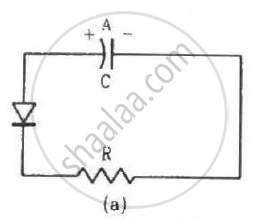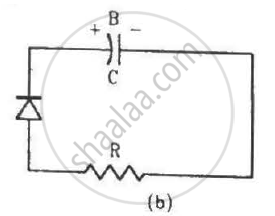Advertisements
Advertisements
प्रश्न
In a transistor,
विकल्प
the emitter has the least concentration of impurity
the collector has the least concentration of impurity
the base has the least concentration of impurity
all the three regions have equal concentrations of impurity.
उत्तर
the base has the least concentration of impurity
When the emitter of a transistor is forward biassed, the majority carriers move from the emitter to the collector through the base. As the base is thin and lightly doped, only small amount of a combination of electrons and holes takes place, leading to weak base current. This makes the collector current equal to the emitter current.
If we make any other choice for least concentration of impurity, we will have a low value of collector current. Thus, the purpose of a transistor will not be fulfilled.
APPEARS IN
संबंधित प्रश्न
Distinguish between a conductor, a semiconductor and an insulator on the basis of energy band diagrams.
In semiconductors, thermal collisions are responsible for taking a valence electron to the conduction band. Why does the number of conduction electrons not go on increasing with time as thermal collisions continuously take place?
Electric conduction in a semiconductor takes place due to
Two identical capacitors A and B are charged to the same potential V and are connected in two circuits at t = 0 as shown in figure. The charges on the capacitors at a time t = CRare, respectively,


The electrical conductivity of pure germanium can be increased by
(a) increasing the temperature
(b) doping acceptor impurities
(c) doping donor impurities
(d) irradiating ultraviolet light on it.
Indium antimonide has a band gap of 0.23 eV between the valence and the conduction band. Find the temperature at which kT equals the band gap.
When a semiconducting material is doped with an impurity, new acceptor levels are created. In a particular thermal collision, a valence electron receives an energy equal to 2kT and just reaches one of the acceptor levels. Assuming that the energy of the electron was at the top edge of the valence band and that the temperature T is equal to 300 K, find the energy of the acceptor levels above the valence band.
The band gap between the valence and the conduction bands in zinc oxide (ZnO) is 3.2 eV. Suppose an electron in the conduction band combines with a hole in the valence band and the excess energy is released in the form of electromagnetic radiation. Find the maximum wavelength that can be emitted in this process.
Suppose the energy liberated in the recombination of a hole-electron pair is converted into electromagnetic radiation. If the maximum wavelength emitted is 820 nm, what is the band gap?
(Use Planck constant h = 4.14 × 10-15 eV-s, Boltzmann constant k = 8·62 × 10-5 eV/K.)
Find the maximum wavelength of electromagnetic radiation which can create a hole-electron pair in germanium. The band gap in germanium is 0.65 eV.
(Use Planck constant h = 4.14 × 10-15 eV-s, Boltzmann constant k = 8·62 × 10-5 eV/K.)
Let ΔE denote the energy gap between the valence band and the conduction band. The population of conduction electrons (and of the holes) is roughly proportional to e−ΔE/2kT. Find the ratio of the concentration of conduction electrons in diamond to the in silicon at room temperature 300 K. ΔE for silicon is 1.1 eV and for diamond is 6.1 eV. How many conduction electrons are likely to be in one cubic metre of diamond?
The conductivity of a pure semiconductor is roughly proportional to T3/2 e−ΔE/2kT where ΔE is the band gap. The band gap for germanium is 0.74 eV at 4 K and 0.67 eV at 300 K. By what factor does the conductivity of pure germanium increase as the temperature is raised from 4 K to 300 K?
Hydrogen atom in n = 3 state has a lifetime of 10-10 sec. The number of revolutions an electron makes in the n = 3 state before returning to the ground state is ______.
Useful data
`1/(4pi∈_0) = 8.99 xx 10^-34`N m2 C-2; e = 1.60 10-19 C; h = 6.63 10-34 Js; me = 9 × 10-3 kg
Two radioactive substances A and B have decay constants 3λ and λ respectively. At t = 0 they have the same number of nuclei. The ratio of the number of nuclei of A to those of B will be `1/"e"` after a time interval:
A semiconductor is cooled from T.K to T2K its resistance will
In a semiconductor, the forbidden energy gap between the valence, band and the conduction band is of the order of
In a common base configuration Ie = 1 mA α = 0.95 the value of base current is
The energy required by an electron to jump the forbidden band in silicon at room temperature is about ______.
